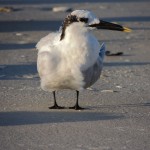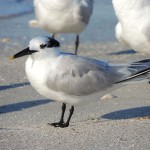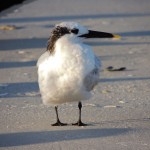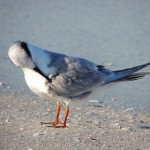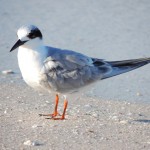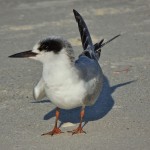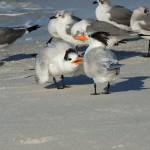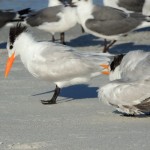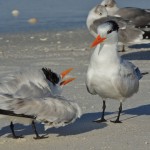22 December 2014. Barefoot Beach, Naples, Florida. This morning we went looking for Black Skimmers. What a bird! They’re related to gulls and have one of the avian world’s oddest modes of feeding: in full flight, its disproportionately long lower mandible slices or skims the surface of the water to sieve and capture whatever might be there. How it distinguishes between the edible, inedible and trip-hazards I’d love to know, whatever the technique, they seem to make it okay. Below is a photo of a skimming skimmer taken near Cape May earlier this year.
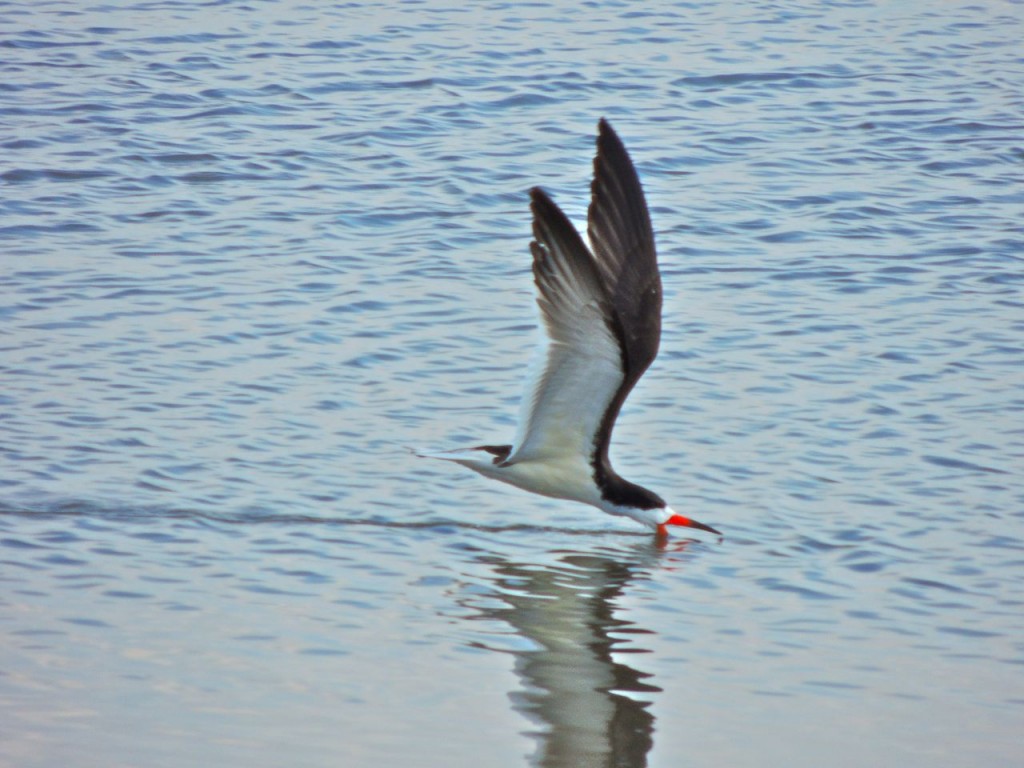
We immediately found a large bunch of Black Skimmers along with a few gulls and terns loafing at the water’s edge, they were very approachable and I could have shot some great portraits had they cooperated. Most of the skimmers were contentedly dozing, their beaks tucked under-wing, and any that looked up did so only momentarily; I was nowhere near quick enough. My morning’s pleasure though, came from the appreciation of three species of terns: Sandwich Tern, Forster’s Tern and Royal Tern.
I had never knowingly seen a Sandwich Tern before this week. Had our friend Eric not casually noted one flying past and commented on its black-with-yellow-tip bill, I probably could have easily overlooked the few that were hanging around. The books distinguish Sandwich Terns from Common and Forster’s Terns by subtle clues: their relatively slender wings, long bill, paler grey upperparts and that yellow-tipped bill; not much to go on. It’s a widespread species and apparently gets its name from the town of Sandwich, England where the first specimen was taken (shot). Still, it’s a rather distinguished looking bird even in winter plumage; in breeding plumage the head has a full jet-black cap and a rather rakish crest, a vestige of which is visible in a couple of the shots above.
On the other hand, I have seen and admired Forster’s Terns many times. There’s a large inland marsh about a two-hour drive from home and Forster’s are more or less the default tern there in the summer months. Field guides are somewhat helpful in drawing attention to what they call the breeding adults’ ‘frosty’ wingtips seen when flying. It’s true enough, once you get the hang of it; at least it helps separate them from Common Terns, which are likely to be not far away, Common Terns’ wings look overall rather dark. These photos also show how, at close quarters, the Forster’s Tern’s red feet are very distinctive; another handsome bird.
Most entertaining were Royal Terns, a few juveniles in particular. There was no shortage of Royal Terns along this stretch of coast, they look and behave very much like our more familiar Caspian Tern; they’re large, can be noisy and have a conspicuously shaggy crest. Last summer’s young are still being cared for by their parents and will remain somewhat dependent on them for another two or three months. One would think that by now they are able to fish for themselves, at least to some extent, but they obviously haven’t given up the expectation of a free handout. We watched a few chicks noisily begging their parent for food using a combination of posture and interminable pleading that few human parents would tolerate for many minutes. The series of shots on the gallery below shows, far more clearly than words can describe, the postures and attitudes of both parent and child, all that’s missing is the wretchedly endless pleading squeals of the youngster.
This post contains many photos in galleries visible only on the website, not if you’re reading this as an email. You can also view many more of my photos of shorebirds, herons and the like in Florida by clicking on this link.
